












By Mark Van der Veer Chief Financial Officer
If you receive electricity from GCEA, you’re not just a customer, you’re a member-owner of a cooperative. This distinction matters, because it means you have a voice in how your co-op operates, and you share in our success.
One of the core principles that sets cooperatives apart is members’ economic participation. Simply put, it means you contribute to the financial health of the co-op and, in return, benefit when the co-op performs well.

Unlike investor-owned utilities that send profits to outside shareholders, our cooperative operates as a not-for-profit utility. GCEA reinvests extra revenue — called margins — into system improvements, keeping rates stable, and preparing for the future. When financially possible, we return a portion of those margins to members. This is called patronage capital, or your piece of the co-op pie.
Patronage capital is your share of the co-op’s excess earnings, based on how much electricity you used that year. Over time, these funds are returned to you — typically on a 24-year cycle. Why 24 years? That timeline reflects the average life of many of our long-term investments in infrastructure, including poles, wires, and substations. Returning patronage capital over time helps ensure GCEA remains financially sound while honoring our commitment to share success with our members.
Each year, GCEA issues a patronage capital certificate that shows your portion

of the co-op’s earnings from the previous year. It’s a reflection of your growing share of allocated margins — and our promise to return that value to you over time.
If you prefer to receive payback sooner rather than later, our Capital Credit Certificate Program provides the option of cashing out the prior year’s allocated patronage capital at a discounted value. This flexibility recognizes that our members may have different financial needs and goals.
Certificates were mailed out mid-June so check your mailbox and be sure to claim your piece of the “co-op pie.” If you have any questions about GCEA’s patronage capital program, visit www.gcea.coop or call 970-641-3520.



By Alliy Sahagun Member Relations Supervisor

Fand demand on the electric grid is greater than ever — especially during peak hours when people return home from their daily activities to cook and take care of household chores. Evening hours are when electricity usage is at its highest.
Peak demand is like rush hour on the highway when all lanes are being used and traffic is at its heaviest. Peak demand puts stress on the grid and causes the system to work harder, which increases the cost for electricity. Simply put, peak demand for electricity costs more in the evening than at other times of the day.
Currently, GCEA combines your total monthly energy used — kilowatt-hours — and peak energy demand — kilowatts — into one charge on your monthly bill. You are also charged the monthly, fixed service availability charge. This two-part rate structure keeps things simple, but it does not address the various ways different members use the grid or give members much control over their electric bills.
Better technology allows GCEA to introduce a three-part rate structure that improves rate equity among members and breaks up the current energy charge into total energy (kWh) and peak demand (kW) charges.
Beginning January 1, 2026, your GCEA bill will show the following charges: Service Availability Charge. This charge provides access to the grid and covers a portion
Peak Demand Charge (kW). This charge is for the highest monthly demand (kW) during the peak hours of 5-9 pm (excluding Sundays).
With this new rate design, you can choose not only to save and conserve energy but also to shift your electricity use away from peak hours to lower your peak demand.
You may be thinking, “I love saving money, but changing my habits and using electricity off-peak seems unrealistic.” I felt the same way at first. As a busy mom of three children, peak time is my prime time when I cram in as much as I can in a few short hours. With some education, my family has quickly learned how to use the delay start feature on our dishwasher and has figured out how to rotate laundry earlier in the afternoon or before going to bed. We don’t skip our chores — we just time them differently now and stop stacking them. Smoothing peak demand can be as simple as using major appliances, such as water heaters or clothes dryers one at a time or turning down the thermostat during peak hours.
If, however, you happen to have a day when you need to use all those appliances at the same time — more power to ya! Our system is built to provide power for all of your electric needs whenever you may need them. Just know that you will now have another mechanism to control your electric bill each month. For more information about peak demand and our new three-part rate coming in 2026, please visit us online at gcea.coop.
For years, GCEA has billed with a two-part rate structure, including service availability and energy (kWh) charges. On January 1, 2026, you will see some changes to your GCEA bill.
Better technology allows us to introduce a three-part rate structure that improves fair cost recovery and breaks up the current energy charge into energy (kWh) and peak demand (kW) charges.
Energy (kWh) refers to the total amount of power used in a month and is measured in kilowatt-hours.
Peak Demand (kW) refers to the highest hourly usage during the month and is measured in kilowatts.
When electricity usage is at its highest demand, we call that a PEAK. Peak demand puts stress on the grid, requiring more generation, transmission, and distribution infrastructure. The peak demand charge fairly charges all members for their contribution to the peak.
NEW PEAK NEW PEAK HOURS: HOURS:
Beginning January 1, 2026, your GCEA bill will include the following charges:
Service Availability Charge: This charge provides access to the grid and covers a portion of the fixed costs for installing and maintaining equipment as well as administrative costs.
Energy Charge (kWh): This charge is for the total amount of energy (kWh) consumed during the month.
Peak Demand Charge (kW): This charge is for the highest monthly demand (kW) during the peak hours of 5-9 pm (excluding Sundays).
You will now have more ability to control your energy use and potentially lower your electric bill.
5 to 9 pm (excluding Sundays)

Know Your Bill: Become familiar with your bill and locate the peak demand (kW) and energy (kWh) readings.
Utilize SmartHub: Download the SmartHub app on your mobile device or access your SmartHub account on gcea.coop. Using the Usage Explorer tool, you can view your energy consumption (kWh) and your demand (kW) for hourly, daily, weekly, and monthly analysis.
Know Your Consumption Patterns: Because when you use your electricity is as important as how much you use, think about when you are using appliances. Do they have timers, thermostats, or delayed start features? If you have a habit of using multiple appliances at once during peak hours, this is your opportunity to change your behavior and put technology to work for you.
Strategize Your Demand: Think about simple changes that can smooth your demand during peak hours. For example, delay start your dishwasher to begin after 9 pm. Start a load of laundry at 9 pm, and throw the clothes in the dryer the next morning. Do the same tasks – just think of different times to do them to lower your demand and avoid increased peak demand charges.


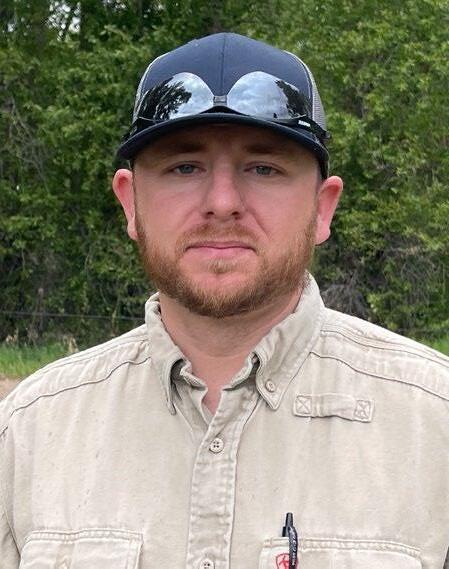
We are pleased to announce that Wyatt Miller has joined the Lake City crew as a journeyman lineman. Strengthening our team with his experience, Wyatt will be working alongside Foreman Logan Rhodes and Apprentice Lineman Kendall Gardner. Wyatt attended Western Nebraska Community College in Alliance, Nebraska, where he earned his Powerline Construction and Maintenance Certificate. He began his career as an apprentice with Colorado Powerline Inc. in Sedalia, Colorado. Wyatt then moved to Wyoming and worked for the City of Torrington, where he achieved his journeyman status before returning to Colorado in 2021. Wyatt may be a familiar face to some of you from his time as a journeyman lineman with the City of Gunnison.
Outside of work, Wyatt enjoys snowmobiling, sideby-siding, hunting and fishing, and spending quality time with family and friends.
Save Energy. Save Money.
With a few simple purchases, you can improve your home’s energy efficiency and reduce your monthly energy bill.
Take advantage of your GCEA membership by applying for rebates on energy-efficient home appliances and equipment.
• Refrigerators, freezers, clothes dryers Heat pump water heaters
• Heat pumps & smart thermostats
• EV chargers & outdoor power equipment
Rebates are available now. Don’t miss your chance to lower costs and your energy bill.
To learn more and apply today, visit us online at gcea.coop
We are pleased to announce that Tanner Hite has joined the Crested Butte crew as an apprentice lineman. Tanner will be working with a skilled and experienced team, including Apprentices Kevin Fox and Zach Bever, Journeyman Lineman Andy Holsteen, and longtime Foreman Jeff Hanggi.

Tanner grew up in Mancos, Colorado, and after graduating from high school, he attended the electrical lineworker program at Colorado Mesa University Technical School. During his time in the program, he earned numerous certifications related to the trade.
Outside of work, Tanner enjoys riding dirt bikes and side-by-sides, snowboarding, fishing, and just about anything that gets him outdoors.
Please join us in giving Wyatt and Tanner a warm welcome as they begin this new chapter with GCEA. We’re excited to have them on our team!


If you are familiar with The New York Times crossword puzzles, you’ll know that they start off on the easier side at the beginning of the week. The puzzles get more difficult each day as the week goes on, until the ultimate challenge: the Sunday puzzle.
I grew up watching my mom solve Sunday puzzles; she grew up watching her grandma solve crossword puzzles, too. It’s with that tidbit of information that you could deduct that I come from a long line of “Word Nerds” (as my husband likes to say).

One thing I look forward to each morning is solving a Times crossword puzzle with my coffee. It has become a simple little ritual, a slow start to the day.
Admittedly, I have never completed a Times Sunday puzzle. I have a small book of Monday and Tuesday puzzles; one takes me about 20 minutes to solve. Though on the easier side, they still challenge my brain to think outside the box, so to speak, to come up with answers to the clever clues.
My team and I have been toying around with the idea of fitting a puzzle into the magazine, and we were able to make it happen in this issue. Turn to page 33 to find it.
We hope you enjoy solving the puzzle. Email me at kcoleman@coloradocountrylife.org and let me know what you think!

STAFF
Cassi Gloe, Publisher cgloe@coloradocountrylife.org
Kylee Coleman, Editor kcoleman@coloradocountrylife.org
Melinda Taylor, Editorial Assistant mtaylor@coloradocountrylife.org
SUBSCRIBERS
Report change of address to your local cooperative. Do not send change of address to Colorado Country Life. Cost of subscription for members of participating electric cooperatives is 30 cents per month, paid from equity accruing to the member. For nonmembers, a subscription is $15 per year in state/$20 out of state.
advertising@coloradocountrylife.org 720-407-0712
National advertising representative: American MainStreet Publications 611 S. Congress St., Suite 504 Austin, TX 78704 | 800-626-1181
Advertising Standards
Publication of an advertisement in Colorado Country Life does not imply endorsement by any Colorado rural electric cooperative or the Colorado Rural Electric Association. Colorado Country Life (USPS 469-400/ISSN 1090-2503) is published monthly by Colorado Rural Electric Association, 5400 Washington St., Denver, CO 80216-1731. Periodical postage paid at Denver, Colorado. ©2025, Colorado Rural Electric Association. Call for reprint rights. View advertising and editorial policy terms and conditions online at coloradocountrylife.coop.
Denver Corporate Office 5400 Washington St. Denver, CO 80216
info@coloradocountrylife.org 303-455-4111
Editorial opinions published in Colorado Country Life magazine shall pertain to issues affecting rural electric cooperatives, rural communities, and citizens. The opinion of CREA is not necessarily that of any particular cooperative or individual.
















Get a $29 Keep Colorado Wild Pass with your next vehicle registration to create sweet summer memories. The pass gives you entry to all state parks and supports wildlife conservation.

By Scott Flood
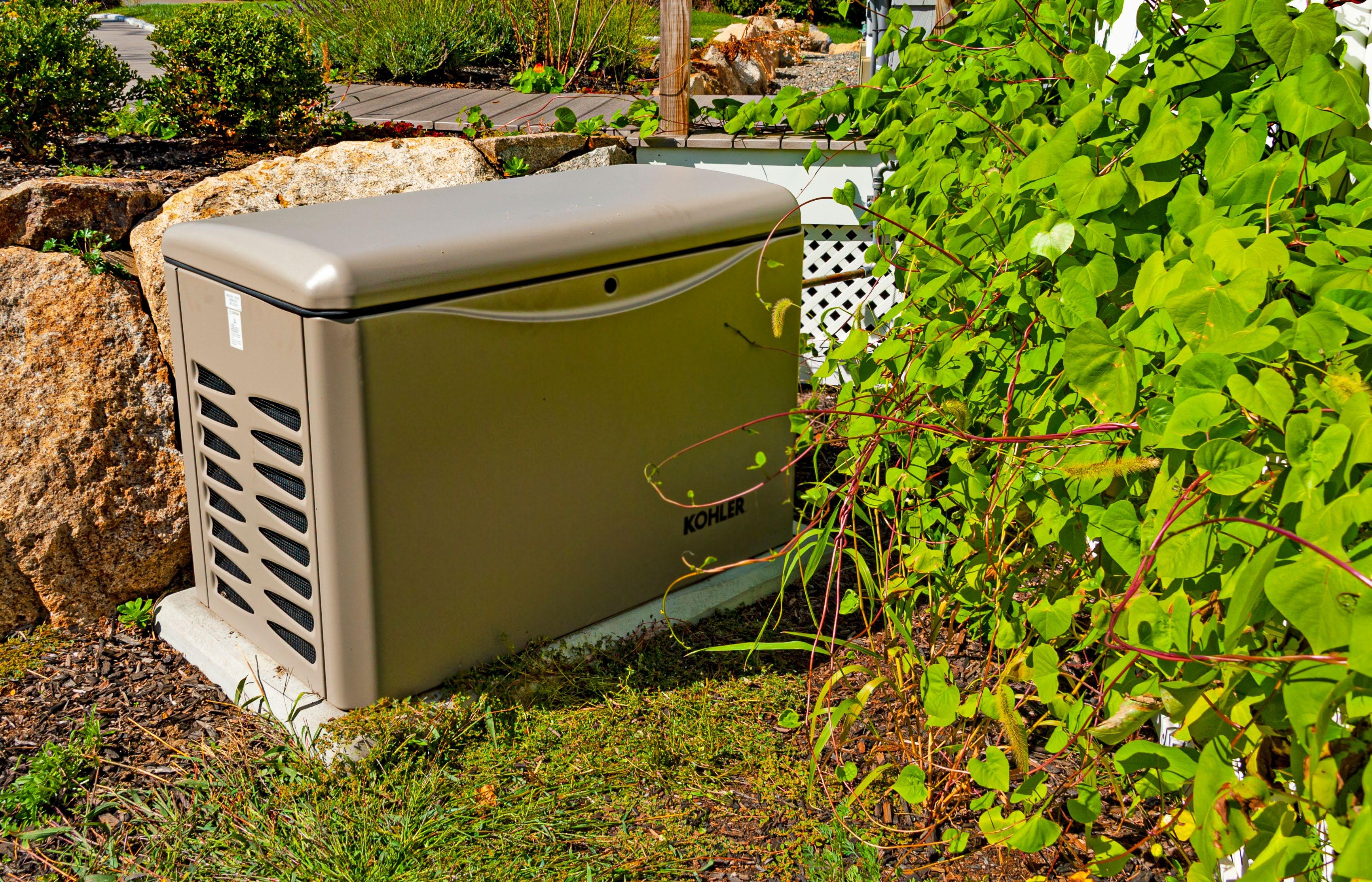
The wind howls outside your windows as a major storm system blows through the area in the late evening. Your lights flicker for a moment or two before you’re plunged into darkness. The social media feed on your phone is packed with reports of damage and power outages, and the storm shows no sign of letting up for hours.
Fortunately, you had the foresight to buy a backup generator big enough to handle your refrigerator, freezer, and other needs. Flashlight in hand, you attach extension cords. Within minutes, you hear the quiet humming that tells you they’re working again.
Colorado’s electric cooperatives understand power outages are a major inconvenience, and we do our best to prevent them. But when severe weather rolls through, outages can sometimes stretch into several hours after a major storm.
Lineworkers may have to check many miles of power lines to pinpoint the problems before they can begin their work to restore service. Many co-op members consider buying backup generators to provide for their family’s needs while waiting for service to resume.
Backup generators fall into one of two categories. Standby generators are permanently wired into the home’s electrical system by a qualified electrician. They come in a variety of sizes, so homeowners can match the generator to their home’s power needs.
Portable generators, as the name implies, can be moved to wherever they are needed. Because they’re small enough to move, they generally provide less power than standby models. Most use gasoline or diesel fuel, and when they’re operated correctly, both types provide a safe source of backup power.
Some homeowners make the mistake of plugging their backup generators directly into a wall outlet or connecting them to their home’s electrical panel. Beyond the significant risk of electrocution and fire that can create, plugging generators directly into your outlets can send the voltage your generator creates into the power lines connecting your home to the electric grid. That creates a dangerous condition called backfeed, which can seriously injure the lineworkers who are working hard to restore your electricity, as well as anyone who accidentally comes in contact with power lines. Backfeed can also damage the generator.
Standby generators are required to have what’s known as a transfer switch, which should be installed by a qualified electrician. The transfer switch creates a barrier between your home’s electrical system and the outside wires, so backfeed cannot occur. When the transfer switch senses that power has been restored, it switches the power source from the generator back to the outside lines.
The biggest danger associated with backup generators is invisible and deadly. Backup generators burn fossil fuels that produce a variety of gases, most notably carbon monoxide. According to the Consumer Product Safety Commission, one portable generator can produce as much carbon monoxide as hundreds of cars. The agency reports that nearly 100 people in the United States lose their lives each year because of carbon monoxide poisoning from backup generators. That’s why generators should only be used in dry, well-ventilated areas away from your home and garage.
Carbon monoxide gas is not only invisible, but it’s also odorless. The National Institutes of Health warns that carbon monoxide has the potential to kill in as little as five minutes. People exposed to carbon monoxide typically become dizzy, feel nauseated, and experience headaches. Often, they lose consciousness before noticing any symptoms. Anyone exposed to carbon monoxide should be moved to fresh air immediately.
If you purchase a portable backup generator, protect your home and family by taking the time to read the manufacturer’s instruction manual. Never use a portable generator in rainy or wet conditions unless
you keep it shielded from moisture — just be sure to also keep it well ventilated.
When starting a portable generator, make sure nothing is plugged into it. You can reduce the potential for damage to your appliances and lighting by turning them off. After the generator starts, plug them in and turn them on one at a time to make sure you aren’t overloading your generator’s capacity. Unplug appliances from the generator before turning it off. Unless the manufacturer recommends otherwise, always turn the generator off and allow it to cool before adding fuel.
Finally, as with many home appliances, regular maintenance is the key to ensuring your portable generator operates safely for years to come. When storing it, drain the fuel from the tank. In addition, check the oil and fuel levels, filters, and other components once each season so you know it will be ready to run safely and efficiently the next time a big storm blows through.
Scott Flood writes on a variety of energy-related topics for the National Rural Electric Cooperative Association, the national trade association representing nearly 900 electric co-ops.
Always contact your electric co-op first if you want to connect a generator to your electric panel. Improperly installed generators can create backfeed, which is dangerous to your co-op’s linecrews and the community.
• Before you purchase a generator, do your research and purchase the correct size for your needs. Make a list of essential appliances and devices you’ll need to power during an outage, then total the required wattage.
DISCLAIMER: Safety requirements may differ based on the type of generator you purchase. Always read the instruction manual and know how to shut off the generator quickly.
What it will power
Fridge and a few smaller items such as a lamp or a phone charger.
Fridge, laptop, five to 10 lights, phone charger, and a 10K BTU air conditioner.
Fridge, gas furnace, 10K BTU air conditioner, dishwasher, multiple lights, TV, laptop, and more.
Powers nearly all home appliance and electronics simultaneously.
Enter to win an outdoor blanket to bring on your stargazing adventures this summer! This blanket has a waterproof outer shell, rolls up for carrying and storage, and is machine washable.
Turn to page 18 for the best places to view the night skies.
To enter the contest, scan this QR code or fill out the form at coloradocountrylife.coop/ ccl-monthly-giveaway
If you need another way to enter our contests, send a letter or postcard with your name, phone number, address, and the name of your electric co-op to 5400 Washington St., Denver, CO 80216.
We will randomly draw one name to win the blanket on July 20.



•
•
•
•





































By Melinda Taylor Editorial Assistant

The awe-inspiring Perseid meteor shower will be on display this summer from July 17 through August 23. The very best time for viewing is in the early morning hours before dawn. Sometimes it’s hard to escape the bright lights of cities and towns, but thanks to public support, Colorado boasts 12 certified Dark Sky Parks and six Dark Sky Communities. Almost anyone in Colorado with reliable transportation can access a certified Dark Sky Place within 90 minutes.
According to DarkSky International, a certified Dark Sky Park is “land possessing an exceptional or distinguished quality of starry nights and a nocturnal environment that is specifically protected for its scientific, natural, or educational value, its cultural heritage, and/or public enjoyment.” A Dark Sky Community is a city or town that has shown dedication to night-sky preservation through outdoorlighting ordinances, education, and other efforts.
DarkSky International strives to combat the negative effects of light pollution around the world, protect nocturnal species, and allow astronomers to conduct research. It began in 2001 and has certified more than 200 places on Earth as Dark Sky Places. For more information on DarkSky International, visit darksky.org. For Colorado-specific information, visit darkskycolorado.org.
1. Black Canyon of the Gunnison National Park
2. Browns Canyon National Monument
3. Curecanti National Recreation Area
4. Dinosaur National Monument
5. Florissant Fossil Beds National Monument
6. Great Sand Dunes National Park and Preserve
7. Gunnison Gorge National Conservation Area
8. Hovenweep National Monument
9. Jackson Lake State Park
10. Lake Fork Earth and Sky Center
11. Mesa Verde National Park
12. Top of the Pines
1. Crestone
2. Norwood
3. Nucla and Naturita
4. Paonia
5. Ridgway
6. Westcliffe and Silver Cliff

As we think ahead to the season of shorter days and twinkling lights, we’d like to make space to appreciate the people who bring light into our lives.
Has someone helped you through a hard time by saying a kind word, sharing a warm meal, or just by being there? Maybe it was a friend who made you laugh when you needed it most, a neighbor who stepped in when you were struggling, or a stranger whose simple act of kindness stuck with you.
We’d love to hear your story for our December 2025 issue. Keep it short and heartfelt — we’re looking for the everyday stories that remind us how powerful a little light can be. Content may be edited for space and clarity.
• Deadline: September 20
• Word count: 200–300 words
• Submit by
• Email: editor@coloradocountrylife.org
• Online: coloradocountrylife.coop/light-in-the-dark
• USPS: Colorado Country Life, Attn: Editor, 5400 Washington St., Denver, CO 80216
Let’s shine a little light together.
By Eugene Buchanan
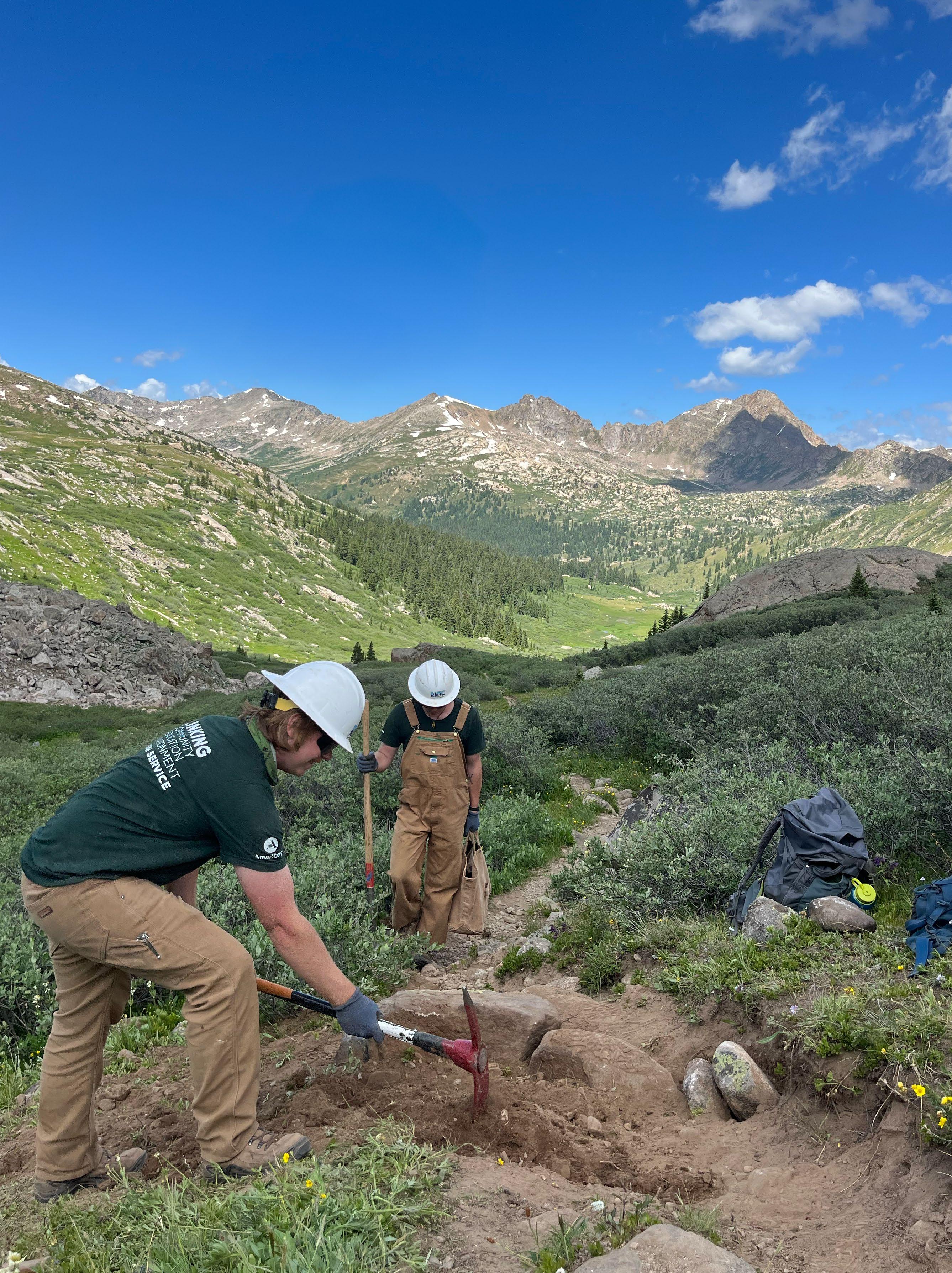
I believe the perfect life means living in a place that inspires you, having a job that is fulfilling, and surrounding yourself with like-minded people. RMYC provides all these opportunities.”
— Loretta McEllhiney, former Colorado Fourteeners Program Manager, USFS
It’s brutal work. I’m at 12,000 feet on an eroded trail on Mount Quandary outside Breckenridge with a team of volunteers, improving the path leading up one of Colorado’s most popular fourteeners. But my shoulders and lower back resent every swing of my Pulaski. Beside us is a Jenga pile of logs that we need to pick up and carry using a vice-like metal claw device and wrestle into position as stair treads. Then we must pulverize rocks with pickaxes to backfill the gaps and secure them in place. Breaking rocks and carrying logs at 12,000 feet ... it’s not a walk in the park.
I’m here as part of a volunteer weekend organized by the Colorado Fourteeners Initiative, bettering the trails for the 300,000 hikers who climb Colorado’s peaks every year and bring $76 million into the state’s economy. Beside me is filmmaker and high-alpine mountaineer Renald Ozturk, as well as crew members from Rocky Mountain Youth Corps, one of eight accredited organizations making up the Colo rado Youth Corps Association. Clamping the device’s metal jaws around a log, we tandem-waddle it into place, tap it down, and begin shoveling.
I can’t say, “This wasn’t in the brochure,” because it is. This is the daily routine for the more than 2,000 conservation service corps crew members in the state who last year improved or maintained 752 miles of trails and mitigated 5,000 acres of wildland fire zones. Celebrating 25 years of engaging youth in the outdoors, the CYCA represents eight corps throughout the state — including Boulder County Youth Corp, Larimer County Conservation Corps, Mile High Youth Corps, Rocky Mountain Youth Corps, Southwest Conservation Corps Four Corners, Southwest Conservation Corps Los Valles, Western Colorado Conservation Corps, and Weld County Youth Conservation Corps. Among other things, these crews work on wildfire fuel mitigation and suppression, trail maintenance, fence construction and removal, invasive species treatment and eradication, energy and water conservation, and historic preservation.
“The awareness of our mission and impact is definitely increasing,” said CYCA Executive Director Scott Segerstrom. “We’re now seen as a critical tool for conser vation and are even being invited to the table for input on policies. Corps are now institutionalized into our partners’ operations and are seen as irreplaceable. Our momentum is growing.”
CYCA also provides its participants with valuable work and life skills, while imparting the importance of public lands. “It’s critical that today’s youth have forma tive experiences that reinforce how valuable our natural resources are,” Segerstrom added. “Experiences in the outdoors lead these young people to be informed voters, engaged conservationists, and confident, resilient people. They learn conflict resolu tion, empathy, communication skills, and more, which prepares them to be positive members of their communities. They not only find their purpose in the corps world — they get to share that purpose with others.”
But as I’m discovering on Mount Quandary, it can also be an uphill battle. Espe cially in the wake of hiring freezes and cuts to public land partners. In fall 2024, the U.S. Forest Service announced it would suspend all seasonal hiring for the 2025 season, cutting about 2,400 jobs — the largest single-year staff cut in recent memory. Add the recent cuts to the National Park Service, Bureau of Land Management, and Forest Service — all of which are youth corps program partners — and the situa tion spirals.
Nearly all the Forest Service’s earlier cuts were field-based jobs, including biolo gists, timber workers, trail technicians, and recreation staff. And the cuts also affect CYCA’s accredited corps affiliates, which put young adults out in the field.

All photos courtesy Rocky Mountain Youth Corps continued on page 22
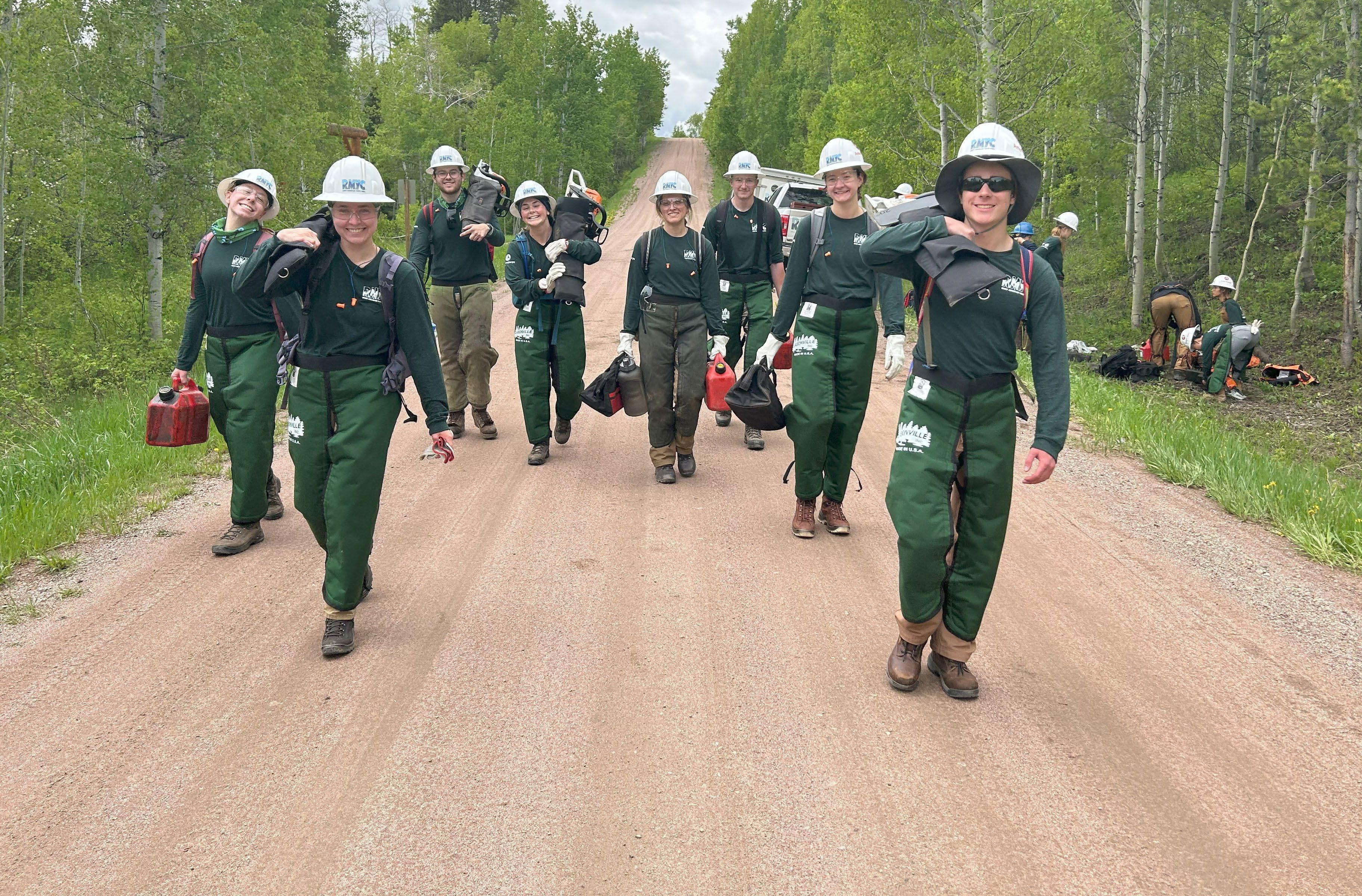
Putting one foot ahead of the other through all these hurdles is CYCA affiliate Rocky Mountain Youth Corps, based in Steamboat Springs. The Forest Service cuts will likely affect them, as their crews do a lot for the Medicine Bow-Routt and White River national forests.
That said, it’s still shaping up to be a robust year for RMYC. Housed in a 4,300-square-foot building on a 3.4-acre campus in Steamboat Springs, RMYC has served nearly 14,000 youth in its three decades of service, including more than 5,000 through its Yampa Valley Science School program. Its crews work on everything from community cleanups, wildfire mitigation, tree planting projects, trail building, geographic information system programming, historic structure preservation, hydrology and archaeology projects, beetle kill removal, and more. Its burgeoning internship program helps participants pursue land management careers.
Like the clouds RMYC crews deal with in the mountains, all this is a silver lining to the cuts its public lands partners are facing. “We’re strengthening our partnerships with land managers throughout our region and providing meaningful service opportunities to young people," said RMYC Chief Executive Officer Ryan Banks,
who oversees a $7 million operating budget for his crews. “We’re looking forward to another summer helping public land managers complete their conservation projects — especially since now they may be a little shorthanded.”
Banks walks the walk. He spent several years working with AmeriCorps programs before joining RMYC’s full-time staff in 2017 and taking its reins in January 2024 from retiring CEO and founder Gretchen Van de Carr. As with RMYC’s crews, he hit the ground running. Last year, RMYC put more crew members into the field than ever; the corps served more than 850 youth through its various programs, improving 1,621 acres of public lands.
Like the ones joining me on Quandary, RMYC’s crews maintained more than 700 miles of trails and removed or mitigated more than 16,000 trees. Crews are also beefing up their wildfire mitigation efforts, including fielding an all-women’s chain saw and fire mitigation crew. “It’s a pretty male-dominated profession, so whenever we can help increase diversity it’s pretty special,” said Medicine Bow-Routt National Forest Fire Management Officer Chris Green.
Fourteeners are a staple recipient of the corps’ efforts. The Colorado Fourteeners Initiative was formed in 1994 as a partnership of nonprofits, private donors, and public agencies to preserve and protect Colorado’s 58 fourteeners. And they regularly tap corps crews like those from RMYC for their projects. Another fourteener on the receiving end of their tenderloving shovels is Mount Elbert, Colorado’s highest peak at 14,439 feet. Crews from RMYC have spent the last few years giving its stairway to the sky a little love. “The workdays are pretty intense,” said Banks, who’s worked on several fourteeners himself. “You’re up before dawn and need to be off the mountain by 2 p.m. when the storms roll in. But it has a cult-like vibe; people want to work there. Elbert is an iconic peak, and you’re building something that will be there for 100 years.”
Putting in 10-hour days and hiking 3,000 vertical feet each morning from base camp up to 13,500 feet, RMYC crews worked on the peak’s North Elbert and Black Cloud trails, using timber features as treads. Higher on the peak, they used rocks to construct walls and staircases using a grip hoist to haul the stones up to the project site. Over the course of an eightday hitch, or typical work session, a crew would work two days on the lower site to acclimate and then six days higher up.
“RMYC is a longtime partner of ours and an integral part of making our projects happen — especially with our work on Elbert,” said former CFI Field Programs Director Ben Hanus. “It’s a strenuous place to work, but we’re grateful for the help. [RMYC crews] come with training, crew leaders, and great attitudes. Next to CFI staff, they’re the next best qualified to do this type of work.” He’s also glad for the experience it gives the kids. “It lets us introduce trail work to youth who otherwise might not get the experience, while also creating more future stewards of fourteeners.”
Leadville’s Loretta McEllhiney, former Colorado Fourteeners Program Manager for the USFS, has seen firsthand the positive impact corps crews have on Colorado’s natural resources and youth. For her, there is nothing better than helping youth find their calling outdoors. “RMYC provides much of the labor necessary to complete these backbreaking projects,” she said. “These crews help build respect for the natural environment, develop job skills, teach the meaning of service, and provide an opportunity to work in a team environment. The perfect life means living in a place that inspires you, having a fulfilling job, and surrounding yourself with likeminded people. Youth corps provide all these opportunities.”
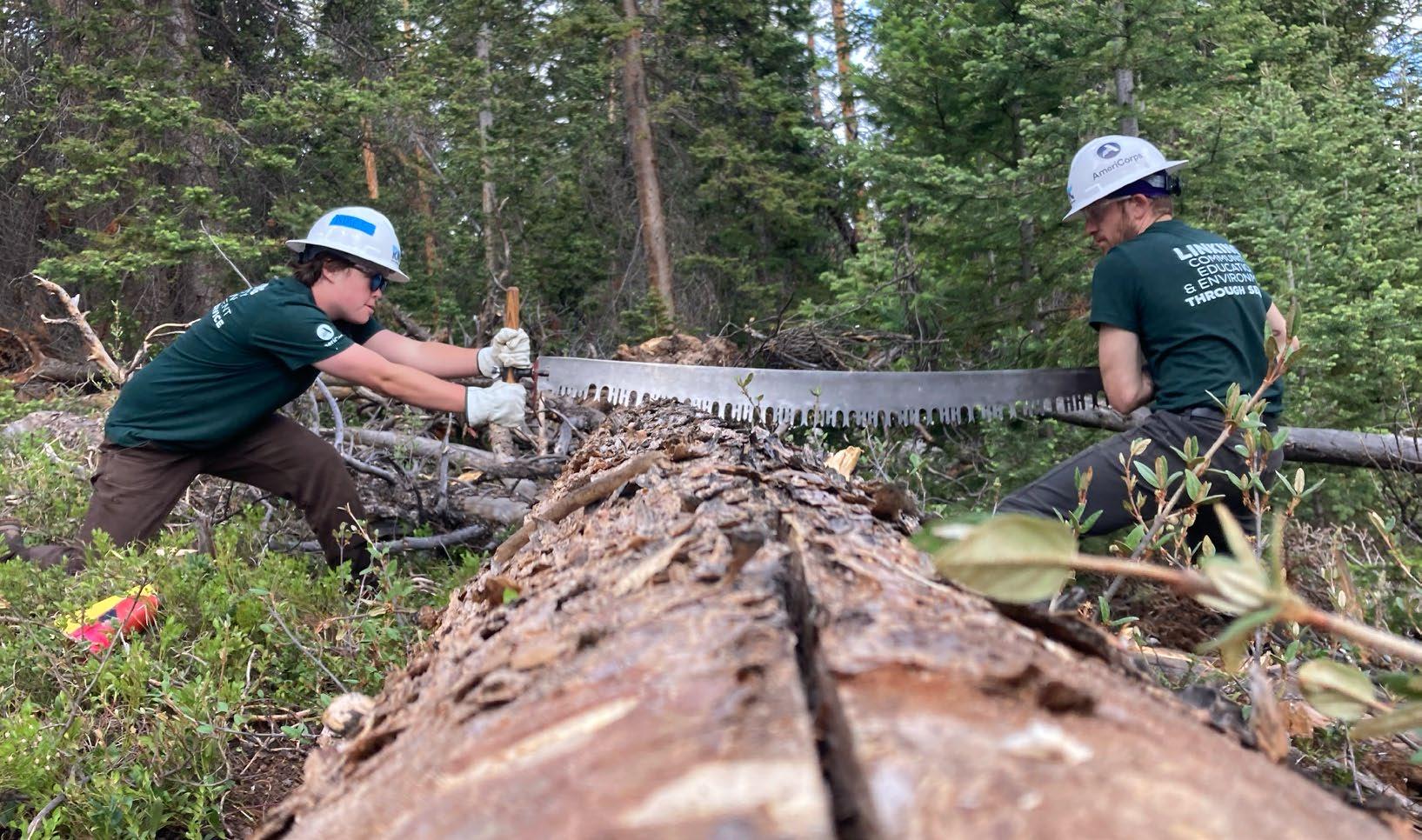

What is a Fourteener?
fȯr-ˈtē-nər\ noun
A mountain with an elevation of at least 14,000 feet.
continued on page 24
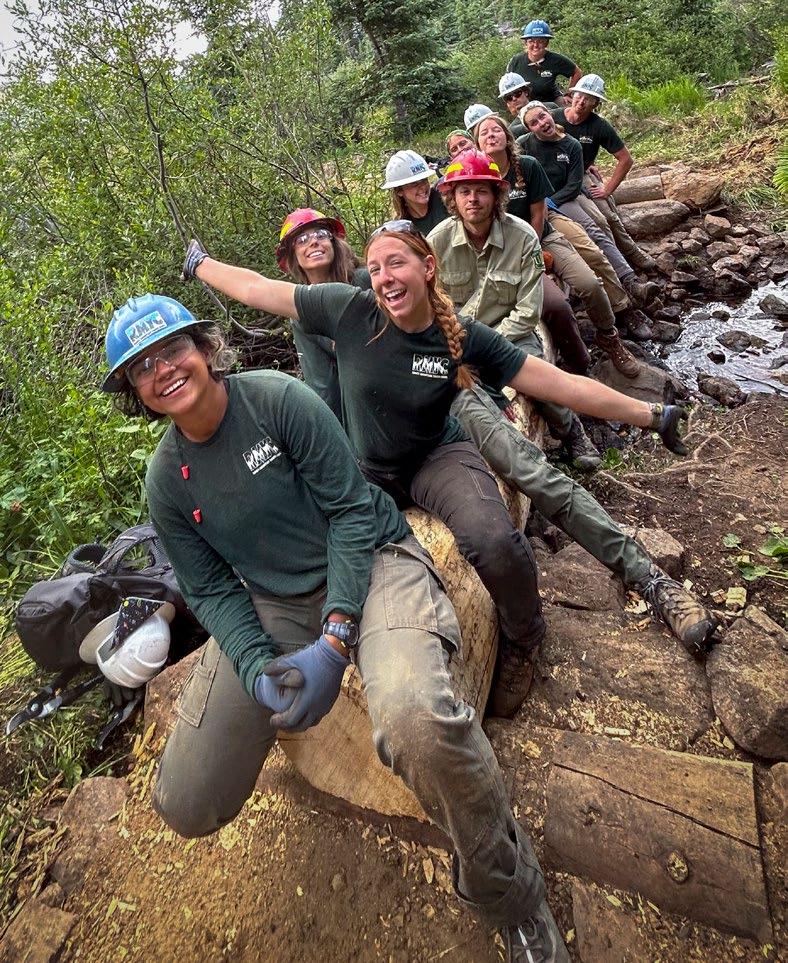
Maintaining trails includes extracting huge boulders. Last year, more than 2,000 conservation service corps crew members improved or maintained 752 miles of trails and mitigated 5,000 acres of wildland fire zones across Colorado.
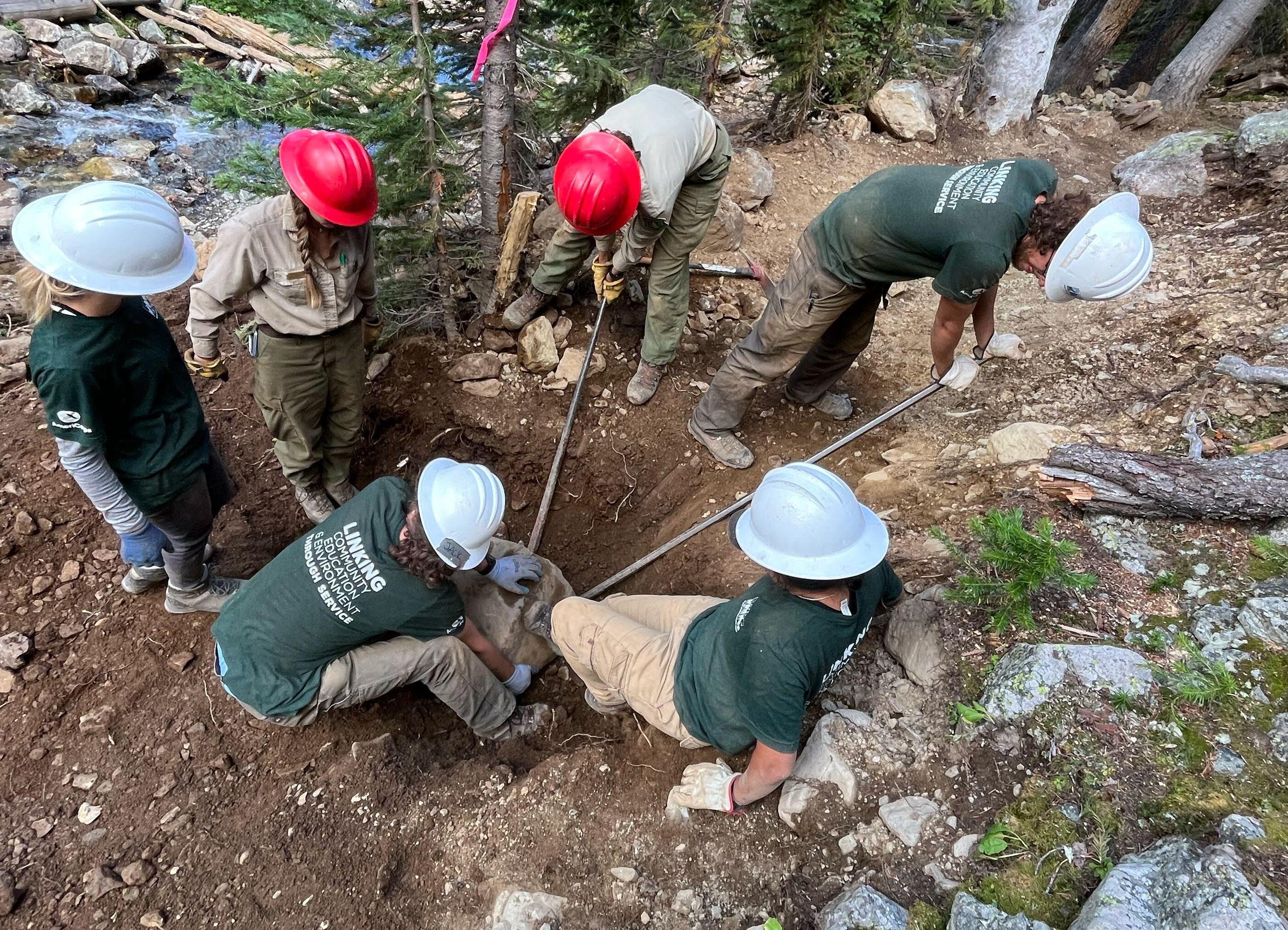
Combine RMYC’s work with that of the state’s other youth corps and, like the trails they maintain, things are going nowhere but up. CYCA is coming off its biggest year ever. “Investment in the corps has tripled in the past three years, from $3 million annually to more than $10 million,” said Segerstrom, who is working with project partners to keep investing in the state’s eight associations and is maintaining corps relations with such entities as the Great Outdoors Colorado lottery trust, the Bureau of Land Management, Colorado Parks and Wildlife, and more.
The 2018 recipient of the Governor’s Service Award for Outstanding Community Leadership, Segerstrom is a former wilderness ranger and wildland firefighter with the U.S. Forest Service who got his start with RMYC. He spent several years leading RMYC’s chain saw and Continental Divide Trail crews, worked on a fourteener high-altitude trail and archaeology crew, and
eventually became the director of RMYC’s conservation corps program. Now at CYCA he manages and disperses the two largest AmeriCorps grants in Colorado and supports a corps sector that has grown to a collective operating budget of $28 million in the state.
All this is good news for CYCA’s eight accredited conservation corps like RMYC, who are eager to pitch in and help. “The cutbacks our partner organizations are facing are definitely unfortunate, but we look forward to picking up whatever slack we can with our land management agencies by continuing to offer meaningful outdoor service opportunities to our crew members,” Banks said. “It’s a win-win for everyone.”
Eugene Buchanan is a former reporter for the Denver Business Journal and 14-year publisher and editor in chief of Paddler magazine. His freelance articles have been published in The New York Times, Men’s Journal, Outside, National Geographic Adventure, Forbes Life, and more. He lives in Steamboat Springs.
Half a mile beneath the icy waters off the coast of Argentina lives one of the most remarkable creatures in the world.
Fully grown, they’re less than 2 feet long and weigh under 10 pounds…
But despite their small size, this strange little squid can have a bigger positive impact on your brain health than any other species on the planet.
They are the single richest source of a vital “brain food” that 250 million Americans are starving for, according to a study published in the British Medical Journal.
It’s a safe, natural compound called DHA – one of the building blocks of your brain. It helps children grow their brains significantly bigger during development. And in adults, it protects brain cells from dying as they get older.
Because DHA is so important, lacking enough of it is not only dangerous to your overall health but could be directly related to your brain shrinking with age. With more than 16 million Americans suffering from ageassociated cognitive impairment, it’s clear to a top US doctor that’s where the problem lies.
Regenerative medicine specialist Dr. Al Sears, says thankfully, “there’s still hope for seniors. Getting more of this vital brain food can make a life changing difference for your mental clarity, focus, and memory.”
Dr. Sears, a highly-acclaimed, board-certified doctor— who has published more than 500 studies and written 4 bestselling books — says we should be able to get enough DHA in our diets… but we don’t anymore.
“For thousands of years, fish were a great natural source of DHA. But due to industrial fish farming practices, the fish we eat and the fish oils you see at the store are no longer as nutrientdense as they once were,” he explains.
DHA is backed by hundreds of studies for supporting razor sharp focus, extraordinary mental clarity, and a lightning quick memory… especially in seniors.
So, if you’re struggling with focus, mental clarity, or memory as you get older…
Dr. Sears recommends a different approach.
Research has shown that our paleo ancestors were able to grow bigger and smarter brains by eating foods rich in one ingredient — DHA.
“Our hippocampus thrives off DHA and grows because of it,” explains Dr. Sears. “Without DHA, our brains would shrink, and our memories would quickly fade.”
A groundbreaking study from the University of Alberta confirmed this. Animals given a diet rich in DHA saw a 29% boost in their hippocampus — the part of the brain responsible for learning and memory. As a result, these animals became smarter.
Another study on more than 1,500 seniors found that those whose brains were deficient in DHA had significantly smaller brains — a characteristic of accelerated aging and weakened memory.
Dr. Sears uncovered that sometime during the 1990s, fish farmers stopped giving their animals a natural, DHA-rich diet and began feeding them a diet that was 70% vegetarian.
“It became expensive for farmers to feed fish what they’d eat in the wild,” explains Dr. Sears. “But in order to produce DHA, fish need to eat a natural, marine diet, like the one they’d eat in the wild.”
“Since fish farmers are depriving these animals of their natural diet, DHA is almost nonexistent in the oils they produce.”
“And since more than 80% of fish oil comes from farms, it’s no wonder the country is experiencing a memory crisis. Most people’s brains are shrinking and they don’t even know it.”
So, what can people do to improve their memory and brain function in the most effective way possible?

MEMORY-RESTORING SENSATION: The memory-saving oil in this Antarctic squid restores decades of lost brain power starting in just 24 hours.
Dr. Sears says, “Find a quality DHA supplement that doesn’t come from a farmed source. That will protect your brain cells and the functions they serve well into old age.”
Dr. Sears and his team worked tirelessly for over 2 years developing a unique brainboosting formula called Omega Rejuvenol
It’s made from the most powerful source of DHA in the ocean, squid and krill — two species that cannot be farmed.
According to Dr. Sears, these are the purest and most potent sources of DHA in the world, because they haven’t been tampered with. “Omega Rejuvenol is sourced from the most sustainable fishery in Antarctica. You won’t find this oil in any stores.”
Already, the formula has sold more than 850,000 bottles. And for a good reason, too. Satisfied customers can’t stop raving about the memory-boosting benefits of quality-sourced DHA oil.
“The first time I took it, I was amazed. The brain fog I struggled with for years was gone within 24 hours. The next day, I woke up with the energy and mental clarity of a new man,” says Owen R.
“I remember what it was like before I started taking Omega Rejuvenol… the lack of focus… the dull moods… the slippery memory… but now my mind is as clear as it’s ever been,” says Estelle H.
“My mood and focus are at an all-time high. I’ve always had trouble concentrating, and now I think I know why,” raves Bernice J.“The difference that Omega Rejuvenol makes couldn’t be more noticeable.”
And 70-year-old Mark K. says, “My focus and memory are back to age-30 levels.”
These are just a handful of the thousands of reviews Dr. Sears regularly receives thanks to his breakthrough memory formula, Omega Rejuvenol
WHERE TO FIND OMEGA REJUVENOL
To secure bottles of this brainbooster, buyers should contact the Sears Health Hotline at 1-888-358-8247. “It takes time to manufacture these bottles,” says Dr. Sears. “The Hotline allows us to ship the product directly to customers who need it most.”
Dr. Sears feels so strongly about this product, he is offering a 100%, money-back guarantee on every order. “Send back any used or unused bottles within 90 days and I’ll rush you a refund,” says Dr. Sears.
The Hotline is taking orders for the next 48 hours. After that, the phone number may be shut down to allow for inventory restocking. Call 1-888-358-8247 to secure your limited supply of Omega Rejuvenol. Readers of this publication immediately qualify for a steep discount, but supplies are limited. To take advantage of this great offer use Promo Code COOM725 when you call.
By Miranda Boutelle
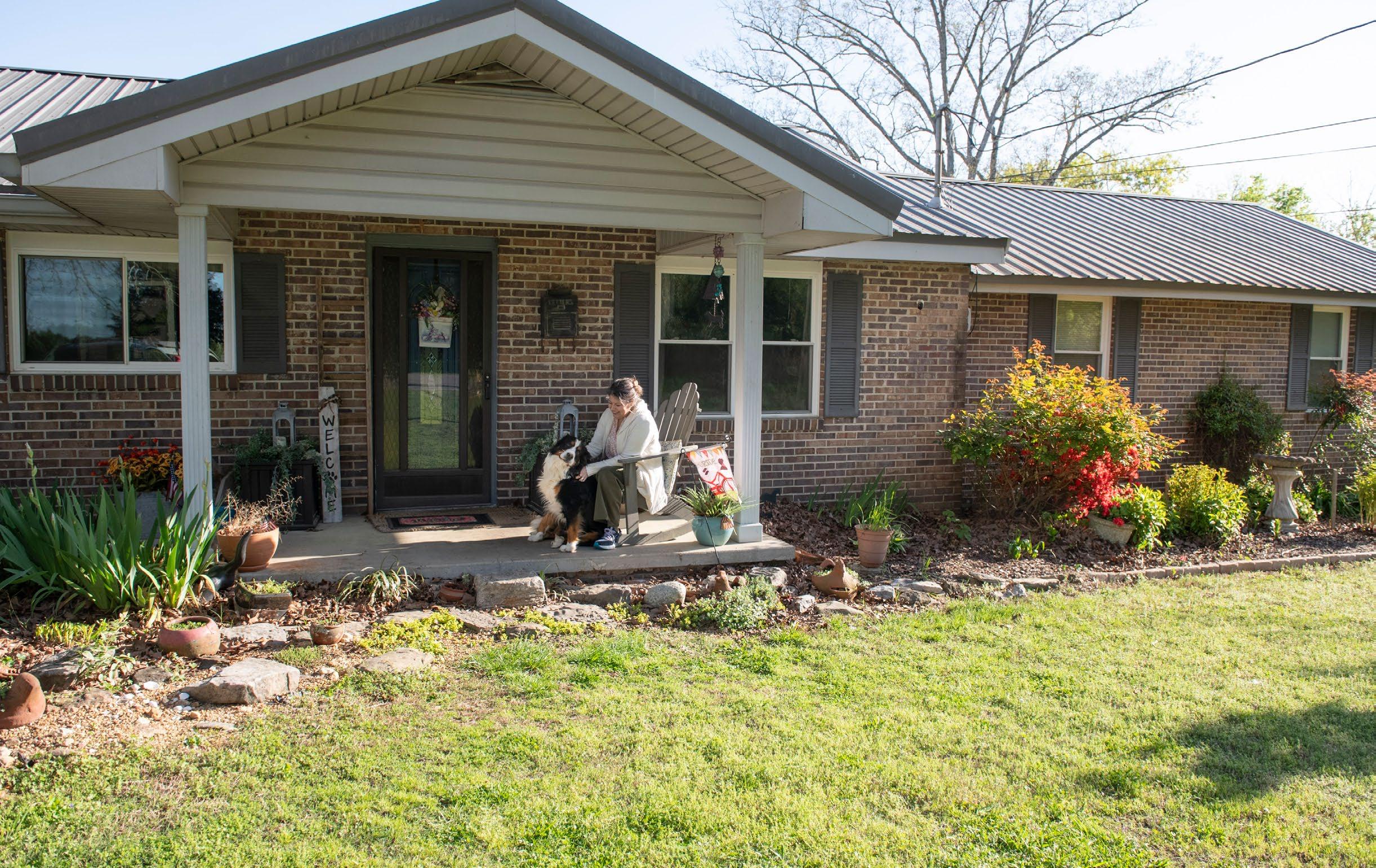
Q: How do I improve the efficiency of my older home while keeping its charm?
A: The features of older homes can make them less efficient than modern construction, but it doesn’t have to be that way. There are ways to keep charm while increasing efficiency.
Start by prioritizing the invisible upgrades that make your home more comfortable and efficient. When we were kids, I don’t think any of us thought, “When I grow up, I want to spend my hard-earned money on insulation.” It’s not as exciting as new countertops or a remodeled bathroom, but air sealing and insulation can save you money every month.
Many older homes are not properly insulated. Insulation has several benefits beyond sealing your home and keeping outdoor air from seeping in. It reduces outdoor noise, makes your home quieter, and improves your overall comfort.
Always properly air seal before you insulate. Older homes with pocket doors, coved ceilings, dumbwaiters, doors to attic spaces, and laundry chutes allow indoor air to escape through the cavities, gaps, and cracks around these classic features. Sealing off open cavities around those features often requires plywood, rigid foam, or drywall fastened into place and then caulked around the edges.
Dense-packed cellulose or closed-cell foam insulation can be sprayed into exterior walls. Skilled contractors can remove pieces of siding and drill holes to fill the wall cavities from the outside of the home. For brick or stone homes, holes can be drilled from the inside and then patched and painted. Insulating walls from the inside of the home requires more time and effort in preparation and cleanup, but having well-insulated walls is worth it.
For safety purposes, knob and tube wiring — commonly used from the early 1880s to the 1930s with no grounding wire — should be replaced before insulating walls and attics. Contact between insulation and knob and tube wiring can create a fire hazard.
Older homes don’t have to be inefficient. Show your home some love and invest in energy efficient upgrades.
Miranda Boutelle is the chief operating officer at Efficiency Services Group in Oregon, a cooperatively owned energy efficiency company. She has more than 20 years of experience helping people save energy at home.









































A summer potluck is a fun and easy way to gather with friends in your backyard without having to do all the food prep yourself. This month we collaborated with electric co-op employees from across Colorado for a virtual side dish recipe swap. These tried-and-true recipes will get you started at your own backyard party or help you decide what to bring to your next cookout.

By Alliy Sahagun Gunnison County Electric Association

Ingredients
3 lb round red potatoes, cut into 1" pieces
1 small red onion, cut into wedges, 1/2 cup
6 cloves garlic, minced
2 tbsp olive oil
• 1 cup frozen whole kernel corn
Dressing
3/4 cup mayonnaise
• 2 tbsp cider vinegar
• 1 oz envelope dry ranch salad dressing mix
• 1/4 tsp cayenne pepper, optional
• 1/2 cup celery, sliced on the bias
• 3 hard-cooked eggs, peeled and chopped
• 1 avocado, halved, seeded, peeled, and chopped, optional
Salt, to taste
• Ground black pepper, to taste
• 1 bunch Italian flat leaf parsley, coarsely snipped, optional
Instructions
Preheat oven to 425 degrees.
Serves 12
Place potatoes, onion, and garlic on a 15" x 10" baking pan. Drizzle vegetables with the olive oil and toss to coat. Roast uncovered for 20 minutes. Stir vegetables and add corn. Roast for 15 to 20 minutes longer, or until vegetables are tender and brown.
For dressing, in large bowl whisk together mayonnaise, vinegar, salad dressing mix, and, if desired, cayenne pepper.
Add roasted vegetables and toss to coat. Stir in celery, eggs, and avocado. Season to taste with salt and black pepper.
Transfer to a serving dish. If desired, sprinkle with parsley.
Serve warm or chilled.




Anne Boswell Southeast Colorado Power Association
Ingredients
1 lb bacon | grits | 5 tbsp butter | 2 eggs | 1 to 2 cups shredded ch
Instructions
• Cook the bacon to your desired level of crispiness. Roughly chop the cooked bacon and set aside.
• Prepare 1 1/2 cups of grits according to the package instructions. Salt and pep per to taste.
• Once the grits are cooked, stir in the butter and melt.
• After the grits are slightly cooled, whisk the eggs into the grits.
• Lightly spray a large casserole dish with cooking spray. Pour the grits into the dish and sprinkle the cheddar cheese and bacon on top
• Bake at 350 degrees for approximately 25 minutes.

By Avery Parson Mountain View Electric Association
Ingredients
• 1 box (12 oz) tricolor rotini pasta
• 1 packet Italian salad dressing mix
• ¼ cup white vinegar
• ½ cup olive oil 10 oz cherry tomatoes, halved
• 8 oz mozzarella pearls
• 6 1/2 oz can sliced black olives, drained
• ½ red onion, diced
• 1 cucumber, peeled and chopped
By Rita Sanders Grand Valley Power
Slaw
2 bags angel hair cabbage/slaw
• Roasted peanuts (not dry roasted), to taste
Dried cranberries, to taste
• 1 large red onion, diced
• 1 bunch cilantro, chopped
Instructions
Mix slaw ingredients in a large bowl. In a separate bowl, whisk together all dress ing ingredients until combined. Pour the dressing over the slaw before serving. Serves 12
Instructions
Cook the pasta according to package instructions until al dente (about 6
While the pasta cooks, prepare the Italian dressing by mixing the packet with white vinegar, olive oil, and water as directed.
Drain and rinse the pasta under cold water, then transfer it to a large mixing bowl.
Add the cherry tomatoes, mozzarella pearls, black olives, diced red onion, and cucumber. Pour the prepared Italian dressing over the salad and mix well
Refrigerate for at least 2 hours or overnight to enhance flavors. Serve chille
1 tbsp chili oil or Mongolian fire oil
• 1 hefty pinch red pepper flakes
• Pinch of salt
• Cracked black pepper, to taste
• 1/3 cup rice vinegar
• 2 tbsp sesame oil
• 1/2 cup mayo



By Becky Jensen
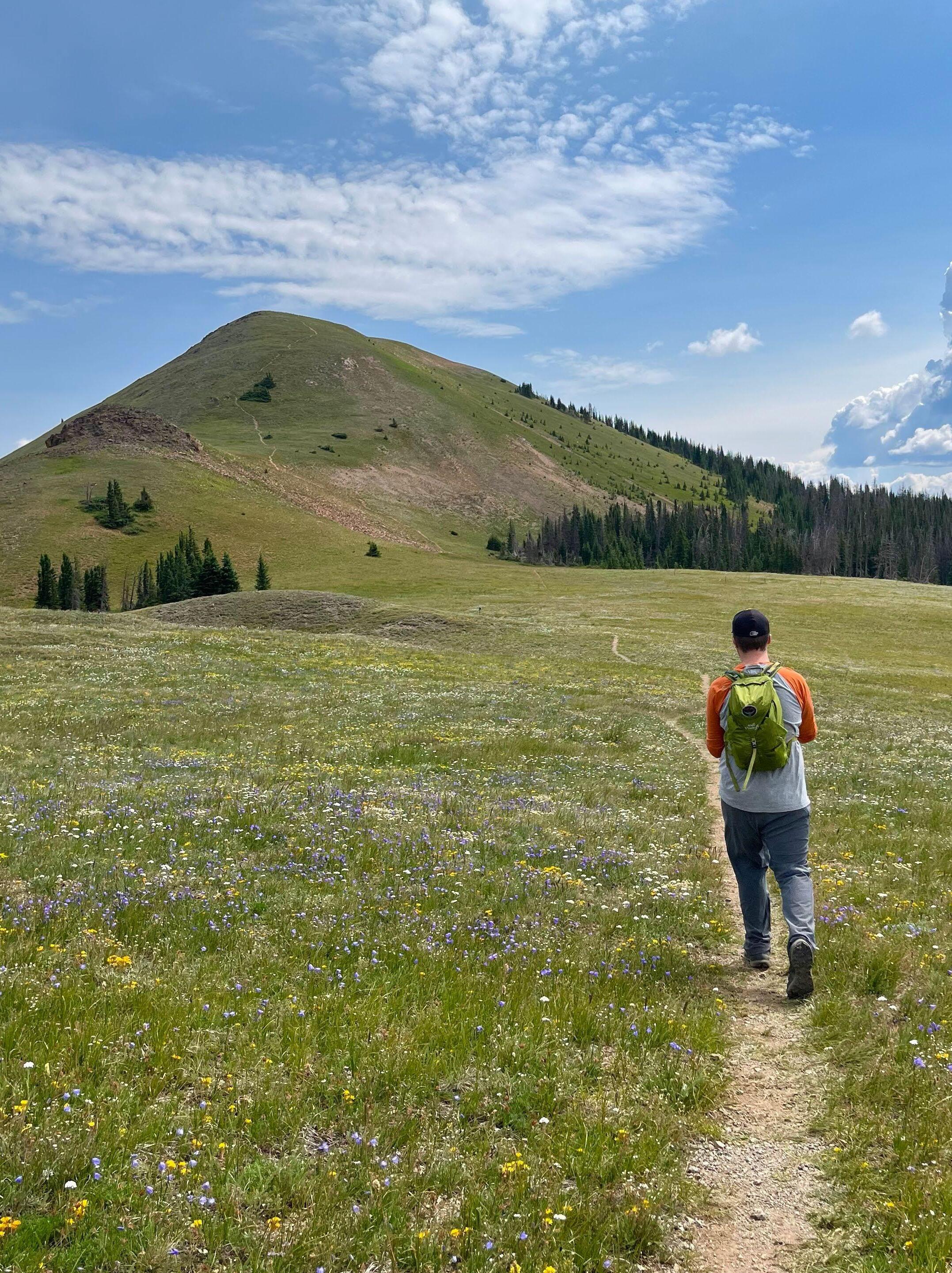
Prepare to slow down and watch for wildlife — including bighorn sheep on rocky cliffs and bold kayakers in the whitewater — as you drive State Highway 14 through Poudre Canyon northwest of Fort Collins. Summer is a great time to experience everything this 40-mile canyon and the Cache la Poudre River have to offer.
Consider a getaway to this special landscape in the heart of Poudre Valley REA’s gorgeous service territory.
Hiking opportunities abound in Poudre Canyon. Popular trails in the lower canyon near Fort Collins include sprawling Hewlett Gulch and the more challenging Greyrock Mountain
To avoid crowds and summer heat, head west to the upper canyon, where you can quickly gain access to the cool alpine and stunning wildflowers on Montgomery Pass Trail

Ten minutes. That’s not a lot of time, but at Colorado’s elevation, that’s all it takes for some people to get a severe sunburn. July is UV Safety Awareness Month and a great time to remember the risks of unprotected sun exposure. Playing it safe in the sun is important for everyone this month and year-round. Regardless of the duration, unprotected sun exposure can have short-term and lasting effects.
Sunburns can make your skin feel hot, tender to the touch, and tight. Immediate symptoms of a sunburn are usually temporary, but over the long term, repeated sunburns can increase your skin cancer risk and lead to leathery skin, dark spots, and wrinkles. Just one blistering sunburn in childhood can double your chances of developing deadly melanoma later in life.
Ten minutes is all it takes to get a sunburn. Take five minutes before your fun in the sun to apply sunscreen and avoid the burn altogether.
Vacations, summer sports, pool time, and backyard barbecues are all signs of a fun summer. Don’t let a sunburn ruin it. Always practice sunsafe strategies no matter the length of exposure.
Seek shade as often as you can, especially between 10 a.m. and 4 p.m. when the UV index is at its highest.
Wear protective clothing: wide-brim hats, UV blocking sunglasses, and SPF rated long-sleeved shirts and pants.
Apply broad-spectrum sunscreen. Use SPF 30 or higher and reapply every two hours. Reapply more frequently if you are in the water or sweating a lot.
Use extra caution near water, sand, and concrete. Reflective surfaces can increase UV intensity and exposure.
The sun’s rays can go through windows, clouds, and light clothing. Daily sunscreen can reduce your risk of UV exposure accumulation.
ACROSS
1. Fad or frenzy
5. Opportunity, so to speak
9. Infiltrator, perhaps
14. Traveling, say
15. Spoonbills do it
16. Pillow filler
17. Juniors, e.g.
19. Fractious
20. Lumberjack’s cry
21. Big beef piece
23. Border duty
25. What tellers do
30. Advent
32. Like a span of oxen
33. “The Water Diviner” actor
36. Redressing
38. Communal pronoun
39. Farmhand, at times
40. Call, in Vegas
41. Broadway handouts
44. Updates a blog
46. Get another magazine
47. Weapon for a trooper
49. Frees from doubt
51. Extreme cruelty
54. Checklist bit
56. High beam? 58. Sousaphones
62. Strip of leaves 64. Word with secret or press
65. “So be it!”
66. Trap starter
67. Frat letter
68. Indicates yes
69. Grown grigs
1. Go on a tirade
2. Expect anon
3. Type of radiation
4. Something to tweeze
5. Overshadows
6. High-quality table wood
7. Coleridge works
8. Pine secretion
9. Became exhausted, with “out”
10. Be a bad witness
11. Campaign creations
12. Trawler attachment
13. Venture
18. Paris flower
22. Library gizmo
24. Savage
26. ___ of hope
27. Out of whack
28. Church dogma
29. A sphere lacks them
31. Breaks the news
33. Coconut product
34. Recreation center posting
35. Grad school grillings
37. Western Colorado sights
39. Bathroom cleaner?
42. “___ don’t say!”
43. Latte preparer
44. Bicycle
45. Hole in the head
48. Empire builders
50. Chair or car style
52. In need of freshening
53. Mercury, for example
55. Office comm.
57. Pilates count
58. Body image, briefly?
59. “Yuck” cousin
60. Quilting social
61. Carpenter at the picnic?
63. Served dinner
© Lovatts Puzzles
Answers on page 34.














• January Nonalcoholic whiskey: Barbara Humbracht, EEA
• February Sushi supplies: Patrice Diem, PVREA
• March Bird book: Karen Dobos, GVP
• April Kid crafts: Barbara Humbracht, EEA
• May Ice cream bowls: Whitni Moebius, GVP










This spring, Colorado Country Life readers responded with generosity to a call for support, and that support is making a real difference. Your donations are bringing a fresh start to families and homes across Navajo Nation.
Ten volunteer linecrews from eight Colorado electric co-ops are participating in Light Up Navajo VI this summer. Each crew spends one week connecting homes that have never had power. Light Up Navajo is a mutual aid initiative of the American Public Power Association and the Navajo Tribal Utility Authority.
Readers helped raise $3,800, which is going directly toward buying a refrigerator for each home Colorado crews help electrify. Your generous donations are offering families safe food storage and a life-changing upgrade in daily living.
Four Colorado electric co-op linecrews have traveled to Navajo Nation to electrify homes, with five more scheduled to go this month. We will share more updates once the trucks roll home.
Thank you for your generous support.
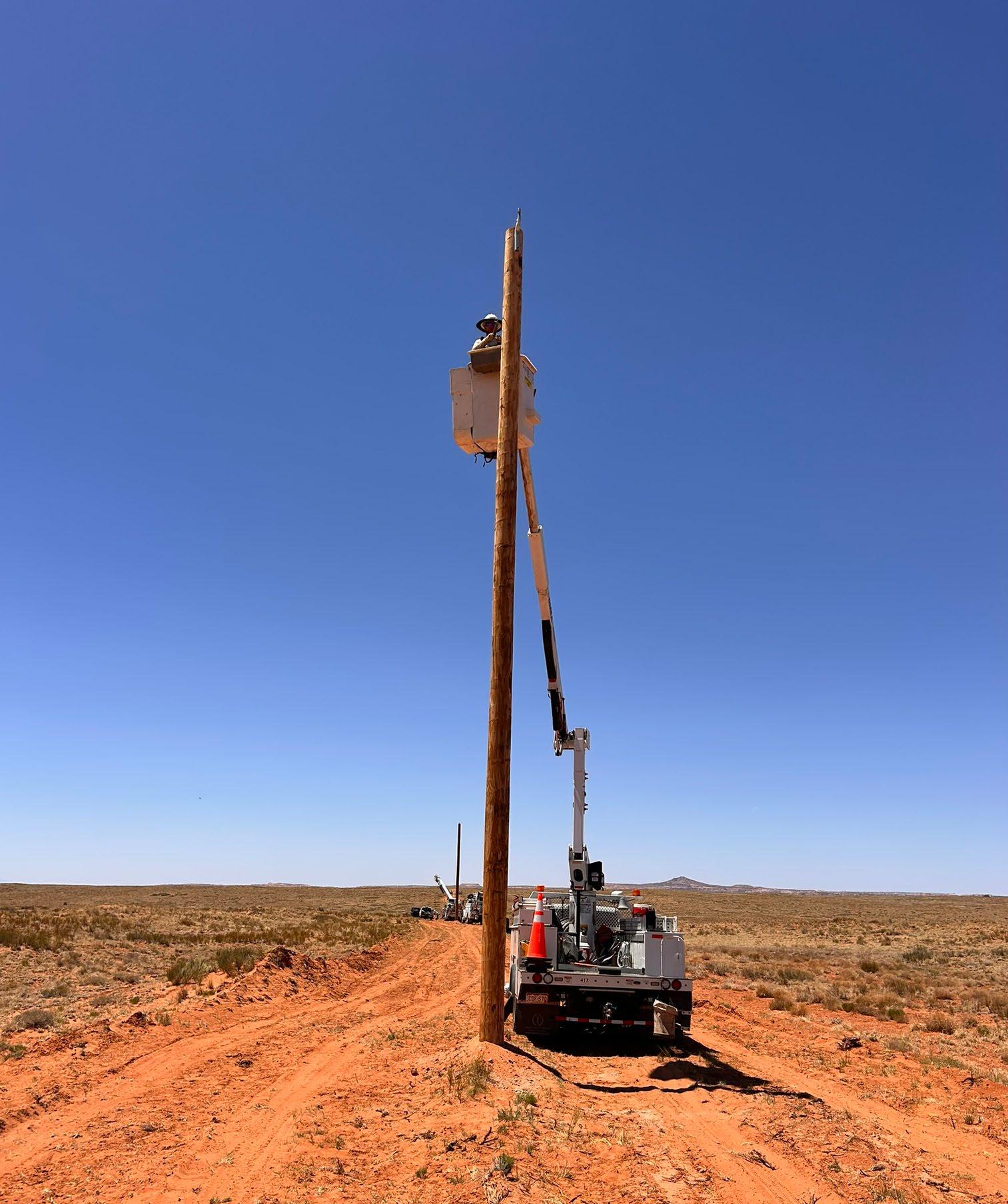
Your next customer is just a page away.
Advertise in Colorado Country Life and get your business in front of 175,000+ engaged readers across Colorado every month.
We’ve got print and digital options to fit your goals and your budget.
Let’s chat about what’s possible.
Email us at advertising@ coloradocountrylife.org.

Picture YOUR BRAND here!


By Gaylene Garcia Granger
One of the best things about summer in Colorado is the abundance of tasty goods found at local farmers markets in cities and towns across the state. Unlike the outdoor markets of old, which mainly featured homegrown produce and meat, today you can meander throughout almost any local farmers market and find arts and crafts by local artisans, specialty food products, home brews, and live entertainment. Here are a few Colorado markets that are sure to fill your basket and your day with joy.

Cortez Farmers Market in beautiful Montezuma County claims to be the oldest market in the state of Colorado, founded in 1973 by Cortez native Bessie White. Her daughter, Cheryl Floyd, still works a produce stand selling her mom’s famous jams and jellies. Word is that the chokecherry is the best.
The market is held at a new location at 601 N. Mildred St. There are 48 vendors who sell fresh produce, coffee, honey, and beef, bison, and yak meat. It’s a market rich in history with plenty of room for the new and trendy. One vendor, Jewelry by Haley, is only 13 years old, but she is a town favorite with her colorful beaded jewelry and art. In September, the Cortez Farmers Market will host a community outreach bike rodeo with local police officers, who will give out 50 bike helmets to local kids.
Visit the market on Saturdays through October 25. Find more information online at cortezfarmersmarket.com.
The Market on Main in Grand Junction is a must visit on your summertime travels. The event typically attracts 5,000 visitors per week with over 100 vendors, 17 of which are local farmers from the Grand Valley. These numbers typically peak in late July when Palisade peaches are widely available on the Western Slope. At the market, you’ll find food vendors, local butchers, bakers, and artists. They are all on Main Street between Third and Seventh streets. According to David Goe, community engagement manager, “We host themed nights and have entertainment past sundown. We also team up with local downtown businesses for special activities like the 600 Block Party.” Market on Main is on Thursday evenings from July 10 through September 25. Find more information online at downtowngj.org/events/market-on-main.
Fort Collins Farmers Market is all about Colorado grown. All vendors grow their own produce, raise their own animals, or craft and package their own food. According to Marketing Director Katie Krull, “The market is great, they always have friendly vendors who work hard to produce different things that go with the seasons. For example, Sweet European Treats will use fresh produce from the market and make unique desserts with them.”
The Fort Collins Farmers Market can be found at 1001 E. Harmony Rd. and runs rain or shine on Sundays through November 9 and Wednesdays through September 24. For more information, visit fortcollinsfarmersmarket.org.
The Woodland Park Farmers Market started in 1990 when the original founders recognized that there were not a lot of options for fresh produce due to the average 8,500-foot elevation of Woodland Park and the surrounding small towns. Today, they’re keeping their cool and selling their goods at Memorial Park, with a stunning backdrop of snow-capped Pike’s Peak in the distance.
Here, customers will find a wide variety of cottage kitchen bakers and producers, fresh eggs, domestic and imported cheeses, in-season produce, local coffee roasters, food trucks, and Colorado beef, yak, and pork, plus local musicians providing entertainment. It retains one of its original six vendors, La Baguette, and has also developed a young entrepreneur program to host young people ages 8-18, to sell their handmade foods and crafts.
The market has received many awards over the years, from being voted one of the top farmers markets in the nation, to a multiyear/multicategory winner for being the best place to meet locals, the best place to hear live music, best outdoor event, and best place to cool off during the summer. The market begins the first Friday in June and runs through the last Friday of September. For directions, visit wpfarmersmarket.com



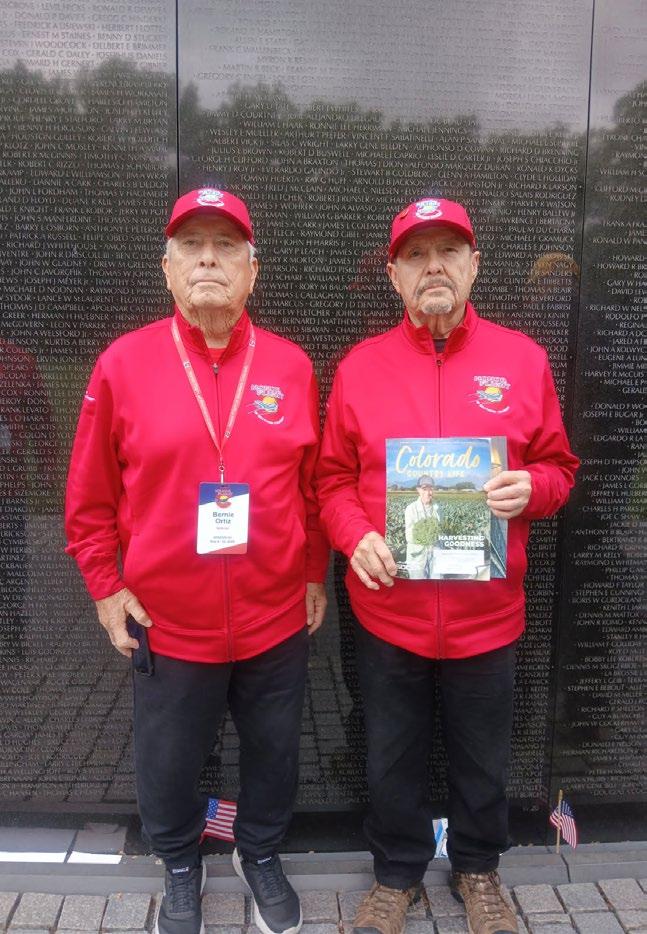
San Isabel Electric Association member Herman Arellano (right) and brother-inlaw Bernie Ortiz travel to Washington, D.C., on Honor Flight #20 recognizing them for their service in the Korean and Vietnam wars. We at CCL thank you for your service and for bringing the magazine on this important trip.
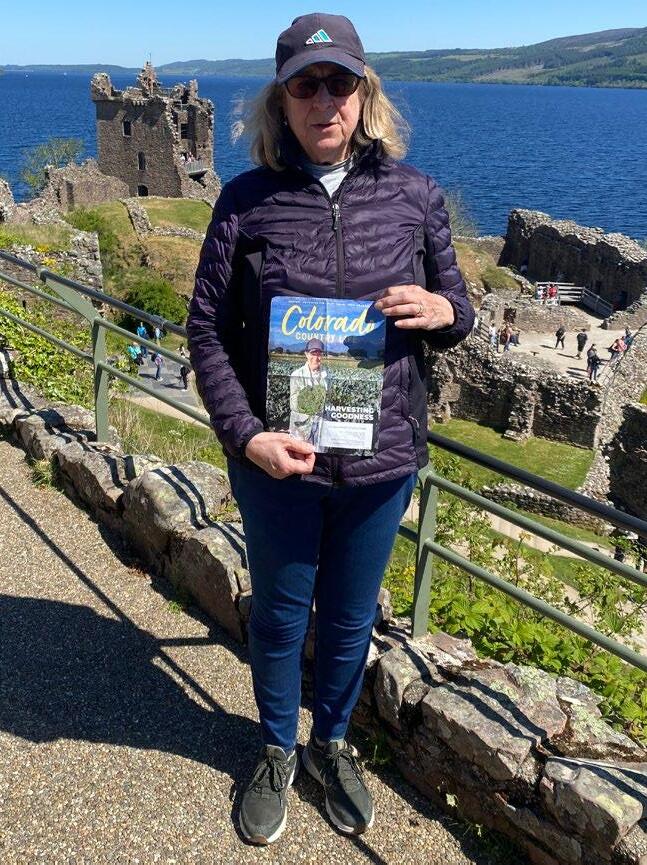
Jan Hopp, a Sangre de Cristo Electric Association member, visits the remains of the Urquhart Castle in Scotland with her copy of CCL.
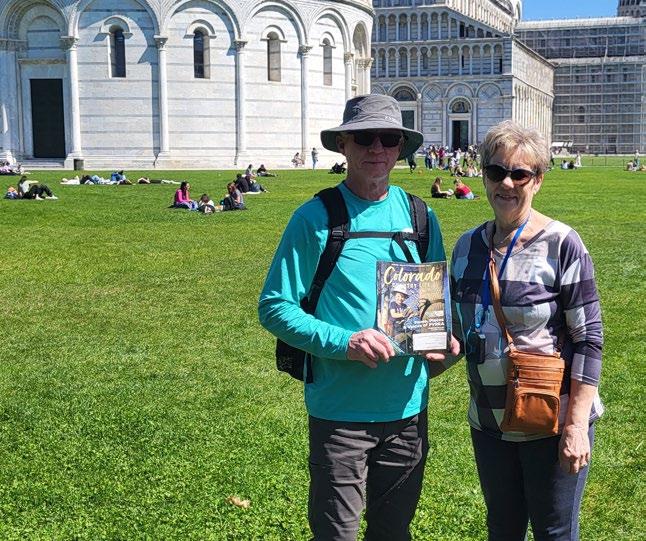
Ron and Joy Harper enjoy the Tuscan countryside and historical Italian sites, including the Leaning Tower of Pisa. The Harpers are members of Poudre Valley REA.
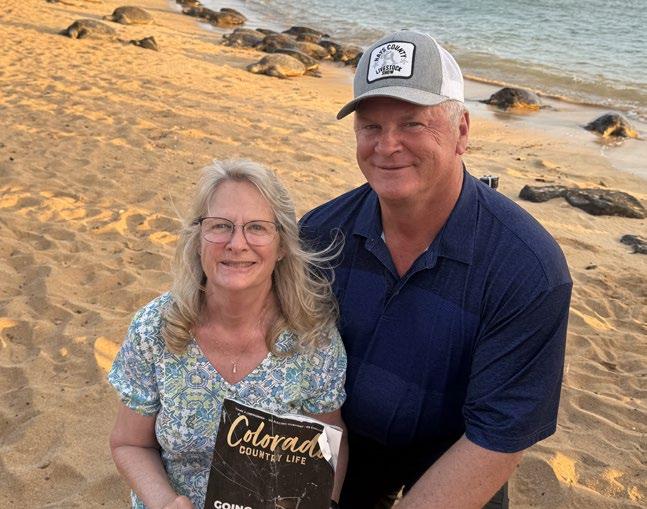
Mountain View Electric members Curtis and Kim Crews bring their copy of the magazine on their trip to Kauai, Hawaii, to celebrate their 27th anniversary with the turtles on Poipu Beach.
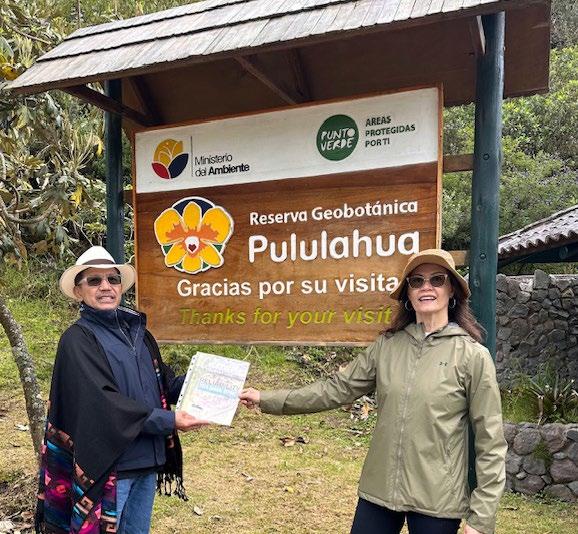
On their way to the Galápagos Islands with their latest issue of CCL, Mountain View Electric members Joe and Winnie Vasquez stop for a photo at Ecuador’s Pululahua Geobotanical Reserve, north of Quito.
Show us where you enjoy CCL for a chance to win! Take a photo of someone (or a selfie!) with the magazine and share it with us on our website at coloradocountrylife.coop. Each month we’ll draw one photo to win $25. See all the submitted photos on our Facebook page, @COCountryLife
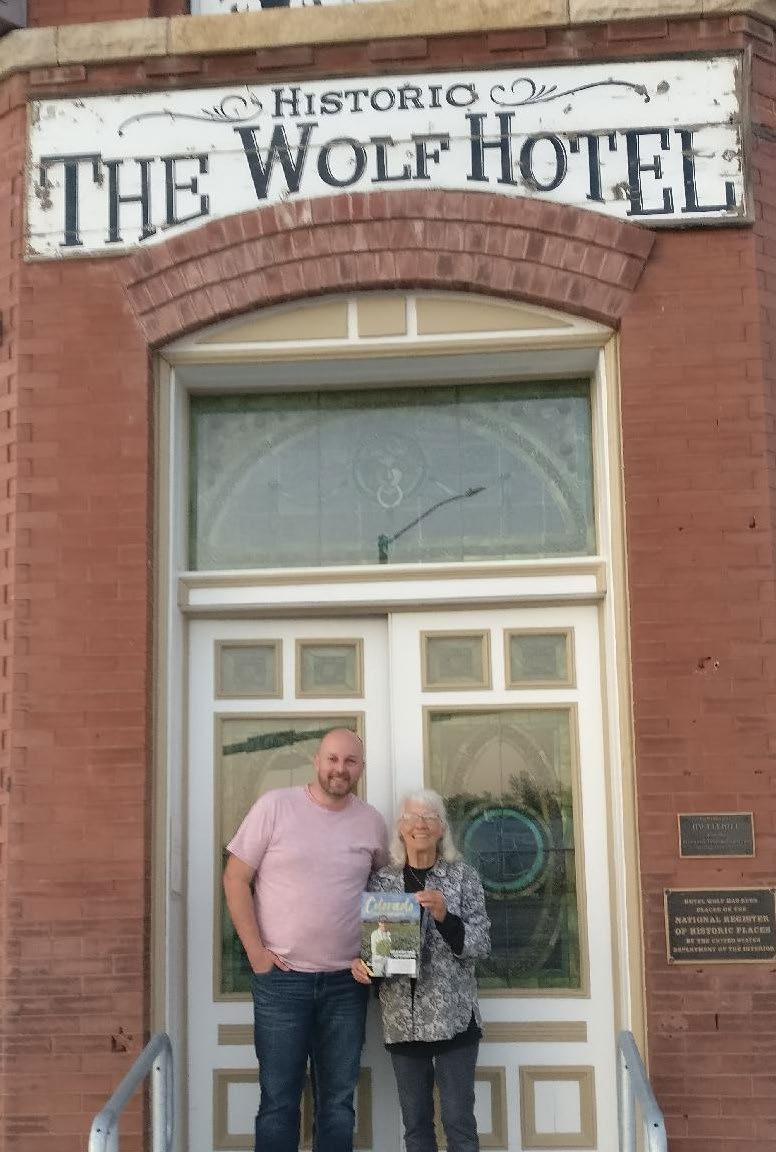
Southeast Colorado Power Association member Judy Davis holds her copy of CCL with The Wolf Hotel owner Chris McCord in Ellinwood, Kansas.
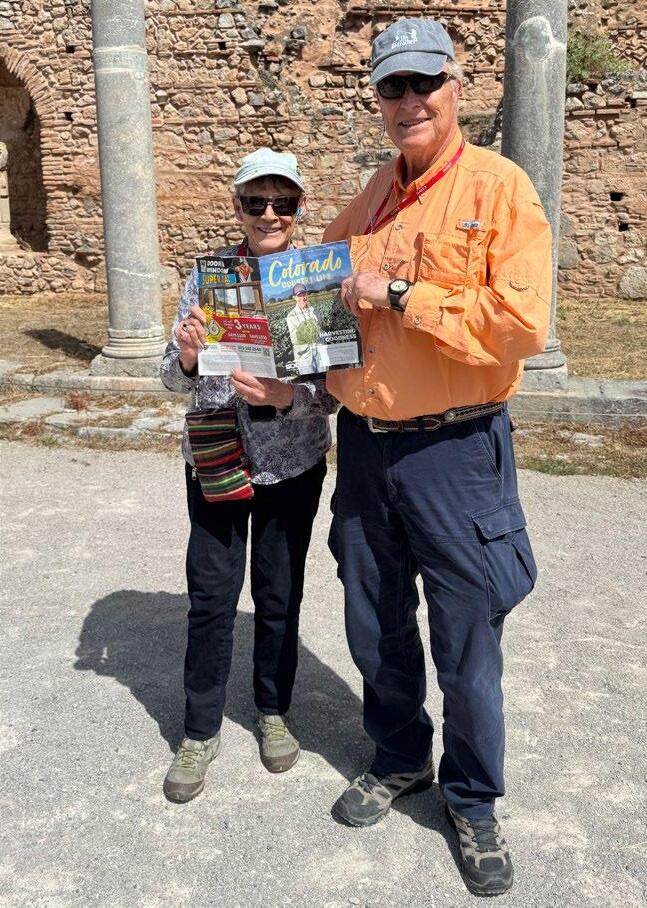
Art and Linda Wilson celebrate their 65th wedding anniversary in Greece, and visit Olympic Stadium in Olympia. The Wilsons are members of Sangre de Cristo Electric Association.
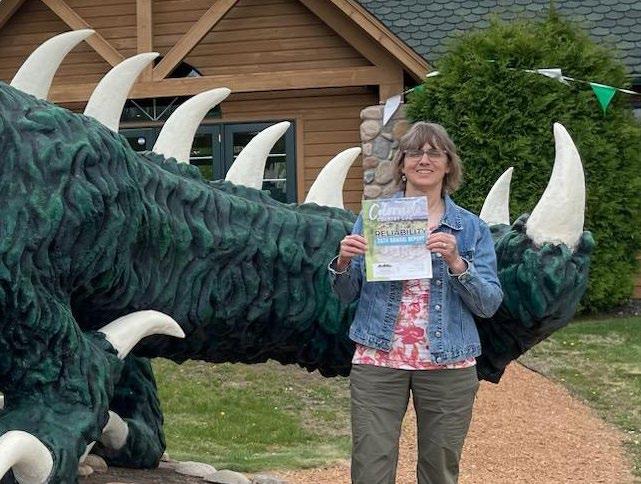
Mountain View Electric Association member Lisa Hatfield brings CCL on a visit to Rhinelander, Wisconsin. Her husband, Mark, is behind the camera taking her photo.
Wildfire risk is an undeniable part of living in the rural West, but it’s a fight we’re facing head-on.
At Tri-State G&T, we deploy data-driven monitoring and wildfire mitigation strategies to identify and mitigate risk to protect our communities and the critical infrastructure they rely on. We’ll do anything within our power to protect the people and places our members call home.
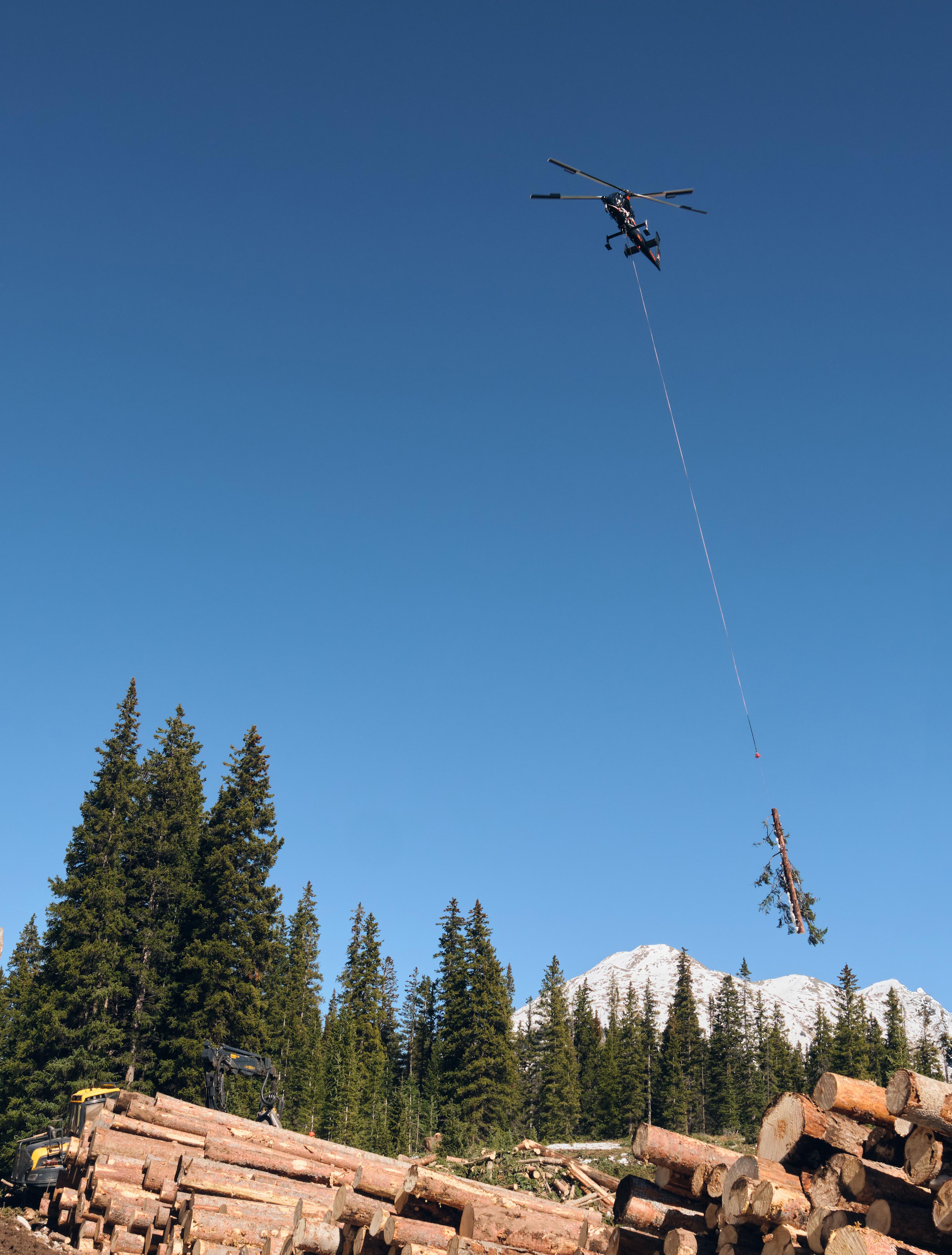
WHATEVER THE FUTURE HOLDS, WE’LL POWER IT.®
Learn more about our year-round wildfire mitigation program here:



